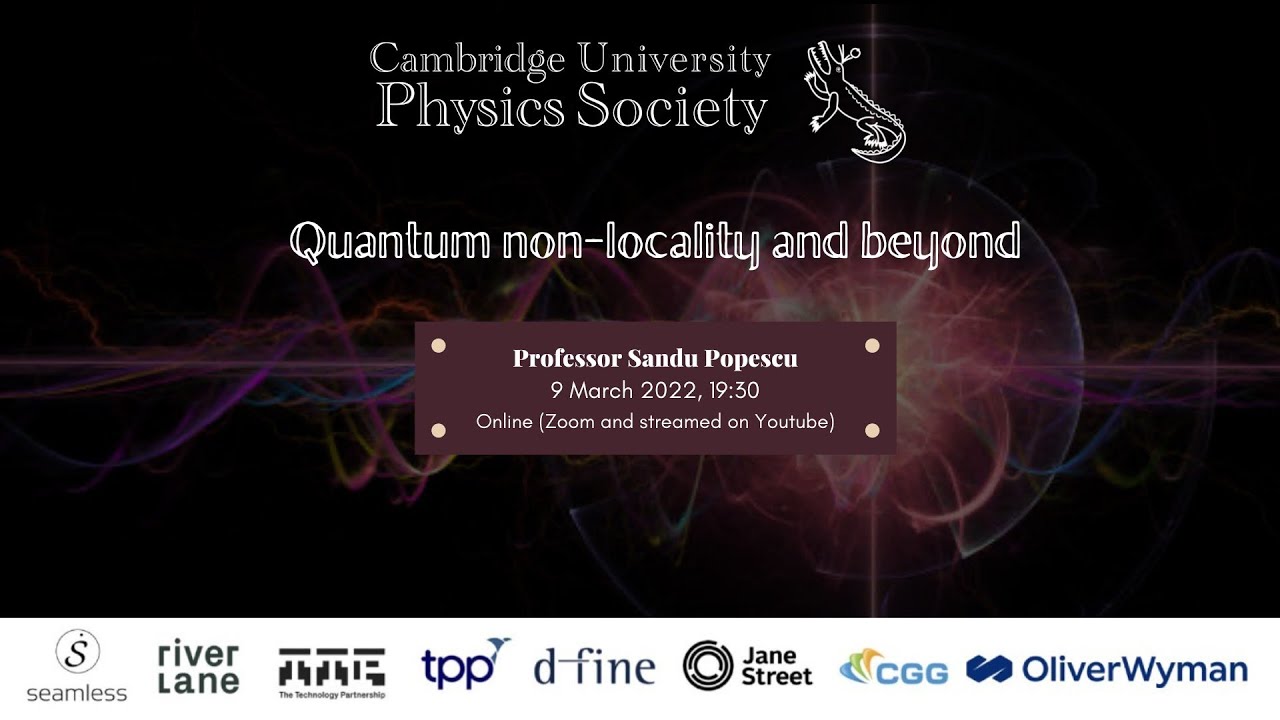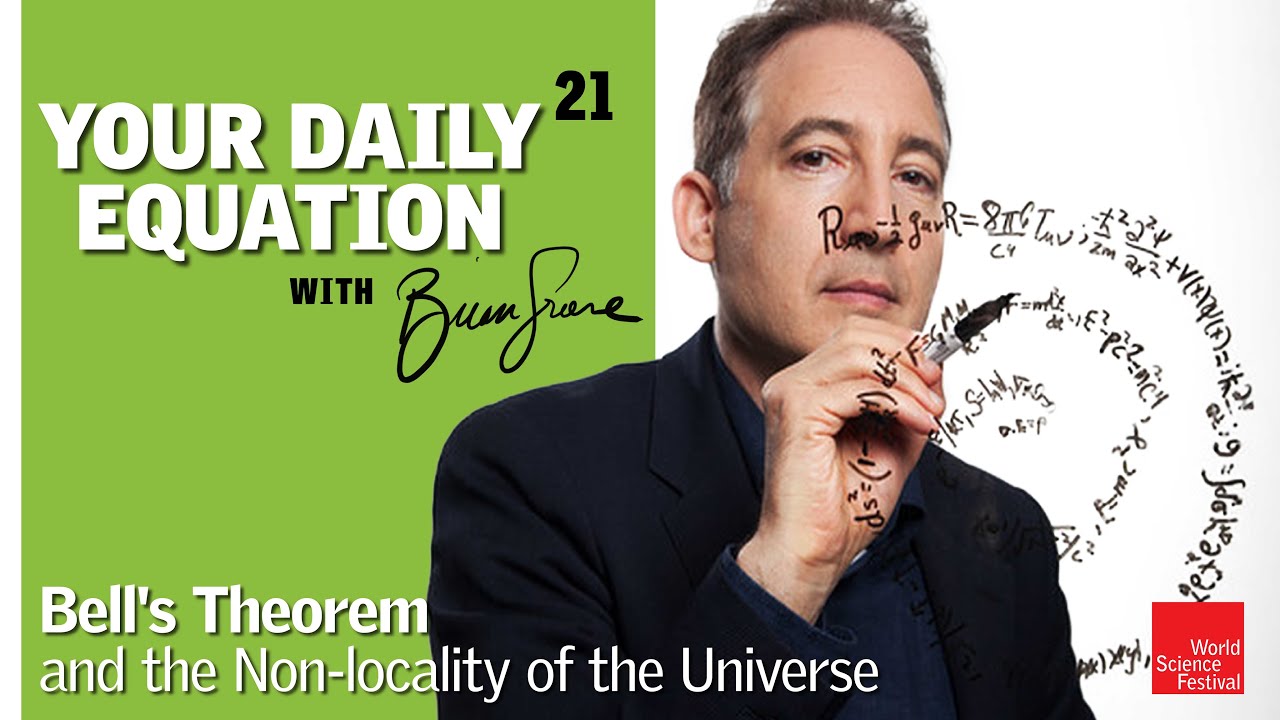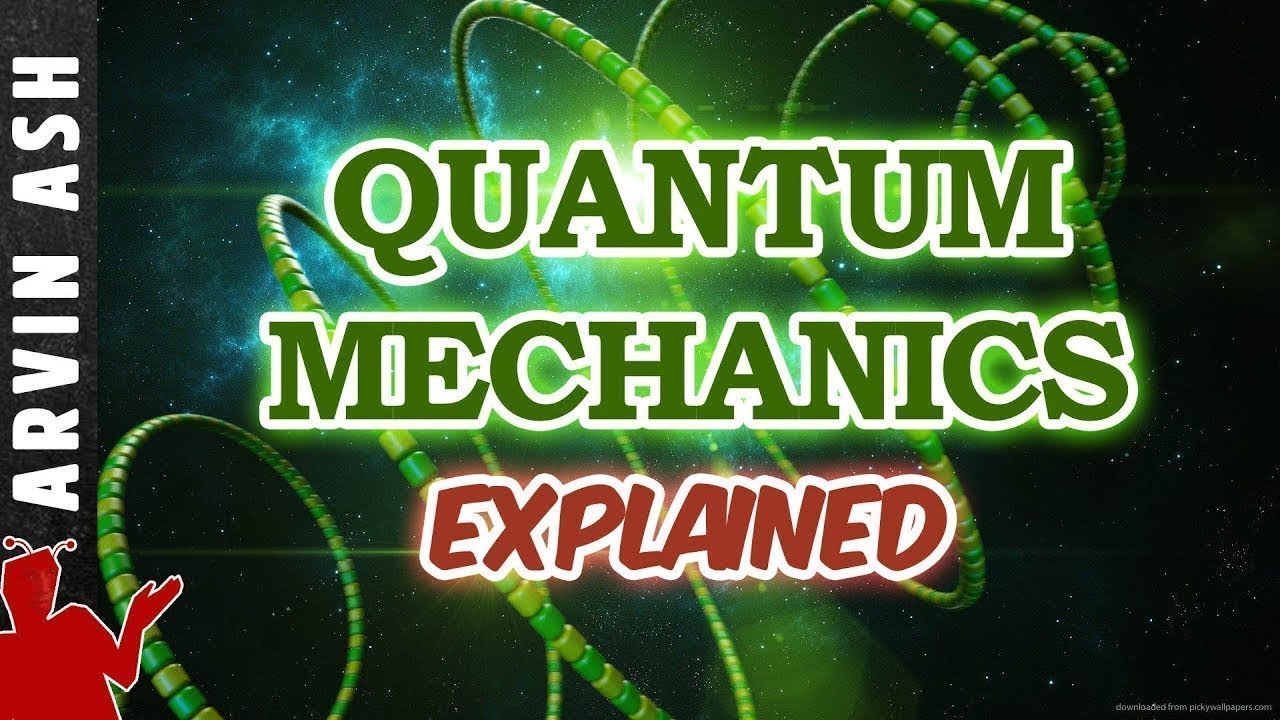Jeffrey Bub: ‘Yes! We have no bananas’
TLDRThe speaker discusses the concept of 'Banana World' from a quantum mechanics perspective, delving into the nature of non-local correlations and the intrinsic randomness of quantum events. They explore the idea of almost quantum correlations, which lie outside the quantum realm but adhere to its principles, and ponder the implications for the measurement problem and the macroscopic world. The lecture touches on the potential for new theories that could explain our universe as being almost, but not quite, quantum.
Takeaways
- 📚 The speaker discusses 'Banana World', a theoretical construct that explores the nature of non-locality and the boundaries of quantum correlations.
- 🔍 The concept of 'device-independent' physics is introduced, which focuses on the correlations and principles of physics without tying them to specific physical devices or ontologies.
- 📈 A key diagram is presented to illustrate the polytope of local correlations and the quantum convex set, highlighting the regions of classical, quantum, and 'super-quantum' correlations.
- 🧩 The idea of PR boxes (Popescu-Rohrlich boxes) is explained, which are hypothetical devices that can produce correlations beyond what is possible in quantum mechanics.
- 🚫 The no-cloning theorem, monogamy, and measurement disturbance are discussed as features of PR boxes that are also characteristic of quantum mechanics.
- 🔑 The intrinsic randomness of quantum mechanics is emphasized as an essential feature, distinguishing it from classical theories.
- 🔄 The script touches on the communication complexity issue, where PR boxes can solve certain problems with minimal information exchange, challenging traditional information theory.
- 🔮 The notion of 'almost quantum correlations' is introduced, which are close to quantum correlations but do not necessarily adhere to the full quantum mechanical framework.
- 💡 The potential implications of living in an 'almost quantum world' are considered, suggesting that our understanding of physics and information may be fundamentally different from current quantum theories.
- 🐱 The measurement problem in quantum mechanics is briefly discussed, hinting at the possibility that an 'almost quantum' theory might offer different insights or solutions.
- 🎨 A connection is made to the arts, specifically the work of Dali, to illustrate the philosophical and conceptual challenges posed by quantum and almost quantum theories.
Q & A
What is the main theme of the workshop being discussed in the script?
-The main theme of the workshop is the exploration of 'Banana World,' a concept that delves into the nature of non-locality and the implications of quantum and almost quantum correlations in physics.
What is the significance of the 50-year milestone mentioned in the script?
-The 50-year milestone refers to the anniversary of Jeff's first publication, which is a momentous occasion for the speaker and symbolizes a long-standing friendship and collaboration in the field of physics.
What is the concept of a 'device-independent' approach in physics as mentioned in the script?
-A 'device-independent' approach in physics refers to discussing physical phenomena in terms of correlations and principles that are neutral with respect to the ontology of the devices producing the correlations, abstracting away from the specific details of the physical systems involved.
What does the speaker mean by 'intrinsic randomness' in the context of quantum mechanics?
-Intrinsic randomness refers to the inherent unpredictability of quantum mechanical outcomes, which are not influenced by any prior events or conditions and cannot be reduced to classical probabilities.
What is the significance of the 'PR box' in the script's discussion?
-The PR box, or Popescu-Rohrlich box, is a theoretical construct that represents a correlation device with inputs and outputs that can exhibit 'superquantum' correlations, which are stronger than those allowed by quantum mechanics.
What is the 'no-cloning theorem' in the context of PR boxes mentioned in the script?
-The no-cloning theorem for PR boxes states that it is impossible to create an identical copy of an unknown quantum state, which is a fundamental principle that applies to PR boxes and prevents certain types of information from being replicated.
What does the speaker mean by 'communication complexity' in the context of PR boxes?
-Communication complexity refers to the minimum amount of information that needs to be exchanged between parties to solve a particular problem. In the context of PR boxes, it raises questions about the limits of information exchange in quantum and almost quantum systems.
What is the 'macroscopic limit' of PR boxes as discussed in the script?
-The macroscopic limit of PR boxes refers to the consideration of large ensembles of PR boxes and the collective measurements of outputs, which can lead to insights about the behavior of these boxes at a macroscopic scale and their implications for signaling and nonlocality.
What are 'almost quantum correlations' as introduced in the script?
-Almost quantum correlations are a generalization of quantum correlations that can be represented using a single Hilbert space and quantum state with commuting projection operators for a particular state, but not necessarily in general. They represent a superset of quantum correlations.
How does the speaker relate the concept of 'Banana World' to the measurement problem in quantum mechanics?
-The speaker suggests that if we live in an almost quantum world, as 'Banana World' implies, the traditional measurement problem in quantum mechanics, which deals with the transition from a quantum state to a definite outcome, may need to be rethought, as the underlying theory might be different from quantum mechanics.
Outlines
📚 Introduction to Quantum Correlations and Banana World
The speaker expresses pleasure in participating in the workshop, highlighting the significance of the event being 50 years after Jeff's first publication. The talk delves into the concept of 'Banana World,' which explores the nature of locality and its puzzling aspects, particularly focusing on device-independent physics. The speaker introduces the idea of correlations and principles in physics, independent of the ontology of the devices producing them, and credits the approach to Peres and Scudo. The main theme revolves around the exploration of the polytope of local color correlations and quantum convex sets, with a diagram illustrating these concepts.
🔍 Quantum and No-Signaling Correlations in Deterministic Boxes
This paragraph delves into the intricacies of deterministic correlation arrays, or 'boxes,' which are arrays with ones and zeros in each quadrant. It explains the concept of no-signaling correlation arrays, where the outputs are intrinsically random and uncorrelated with any event outside their future light cone. The speaker discusses the properties of PR boxes, which are deterministic correlation arrays that cannot be used for signaling, and their role in defining the boundary of quantum correlations. The paragraph also touches on Einstein's discomfort with the intrinsic randomness in quantum mechanics.
🌐 Exploring the Quantum Region and Beyond
The speaker discusses the discovery that classical theories can produce correlations within a certain area, while quantum mechanics extends beyond this area, possibly into an 'almost quantum' region. The paragraph explores the concept of quantum correlation arrays and their intrinsic randomness, contrasting them with deterministic correlation arrays. It also introduces the idea that quantum correlations can be simulated by a combination of deterministic correlation arrays and PR boxes, emphasizing the intrinsic randomness of quantum correlations.
🚫 No-Cloning, Monogamy, and Measurement Disturbance in PR Boxes
This section provides a proof of the no-cloning theorem for PR boxes, explaining that the ability to clone would lead to signaling, which is not allowed by the no-signaling principle. It also discusses the concepts of monogamy and measurement disturbance, which are peculiar features of quantum correlations that apply equally to super-quantum correlations. The speaker emphasizes the importance of these principles in understanding the nature of quantum and super-quantum correlations.
🔄 Communication Complexity and PR Boxes
The speaker introduces a communication complexity issue, where Alice and Bob, separated in different cities, want to determine if the number of days they are both free to meet is even or odd. Using PR boxes, they can solve this problem with just one bit of information, contrasting with the classical world where 365 bits would be needed. The paragraph explores the implications of this for communication complexity and the potential trivialization of communication with super-quantum correlations.
🔮 Macroscopic Limit of PR Boxes and Almost Quantum Correlations
The speaker discusses the macroscopic limit of PR boxes, where collective measurements of outputs can be made for large ensembles of PR boxes. The paragraph explores the question of how noisy PR boxes must be to avoid signaling in the macroscopic limit and introduces the concept of almost quantum correlations, which are close to quantum correlations but do not necessarily require a quantum state or Hilbert space.
🤔 The Measurement Problem and Quantum Theory
In this paragraph, the speaker reflects on the measurement problem in quantum mechanics, which arises when one takes the wave function or quantum state as the truth maker for events. The speaker contrasts the views of Heisenberg and Schrödinger on quantum mechanics, highlighting the disagreements and the challenges in visualizing the quantum state. The paragraph suggests that the measurement problem may not be as pronounced if one adopts a more abstract view of the theory, as Heisenberg did.
🎭 The Big and Small Measurement Problems
The speaker distinguishes between the big measurement problem, which is explaining how a measurement produces a definite outcome, and the small measurement problem, which is explaining how macro-level correlations can be inside the local polytope. The paragraph suggests that measurement outcomes are intrinsically random and that information loss on measurement is a generic feature of any no-signaling theory. It also touches on the idea of an 'almost quantum' world, which may have different dynamics and theories compared to quantum mechanics.
🏁 Conclusion: Speculations on the Almost Quantum World
In conclusion, the speaker suggests that we may live in an 'almost quantum' world, which could have different ontologies and theories compared to quantum mechanics. The speaker emphasizes the importance of not speculating about solutions to the measurement problem if there's a chance that quantum theory may not be the correct theory, and that the right theory could be an 'almost quantum' theory.
Mindmap
Keywords
💡Banana World
💡Non-locality
💡Quantum Mechanics
💡Intrinsic Randomness
💡Correlation Arrays
💡No-Signaling
💡PR Boxes
💡Communication Complexity
💡Macroscopic Limit
💡Measurement Problem
💡Almost Quantum
Highlights
Introduction to the concept of 'Banana World', a theoretical construct for exploring non-local correlations.
The 50-year anniversary of Jeff's first publication and the significance of the long-standing friendship in the field of quantum physics.
The adoption of a device-independent approach to discuss physics, emphasizing correlations and principles over the ontology of devices.
The introduction of the 'P.O. box' concept by Peres and Rosen in 1994, abstracting correlations with inputs and outputs.
Exploration of the polytope of local color correlations and the quantum convex set in the context of non-locality.
The distinction between deterministic and no-signaling correlation arrays and their implications for quantum and classical theories.
The intrinsic randomness of quantum mechanics and its contrast with classical determinism.
The no-cloning theorem for PR boxes and its significance for quantum and super-quantum correlations.
The communication complexity issue and how PR boxes can solve certain problems with minimal information exchange.
The potential trivialization of communication complexity with super-quantum correlations and the need for a balance.
The macroscopic limit of PR boxes and the implications for signaling in large ensembles.
The concept of almost quantum correlations and their distinction from quantum correlations.
The NP-hard problem of determining whether a correlation is quantum or almost quantum.
The potential for new theories that could explain our world as an almost quantum world, differing from standard quantum mechanics.
The discussion on the measurement problem in quantum mechanics and its potential resolution in an almost quantum framework.
The philosophical implications of living in an almost quantum world and the challenges it poses to our understanding of reality.
Transcripts
Browse More Related Video

Professor Sandu Popescu - Quantum non-locality and beyond

Asking a Theoretical Physicist About the Physics of Consciousness | Roger Penrose | EP 244

Your Daily Equation #21: Bell's Theorem and the Non-locality of the Universe

Neil deGrasse Tyson Explores Quantum Entanglement with Janna Levin

Spooky Action at a Distance (Bell's Inequality) - Sixty Symbols

The SIMPLEST Explanation of QUANTUM MECHANICS in the Universe!
5.0 / 5 (0 votes)
Thanks for rating: